-

人教版新目标初中英语七年级下册It’s raining教案2篇
1 Each group choose one place to describe and what you are doing in it Choose one place, and describe what they are doing 2 Move around the room and give suggestions Talk about it and write it down 3 Ask one to show their works and act it Choose one of each group to make a report 4 Evaluate the best group and the best reporter Choose the best one Homework Ask your friends their ideal place and write about it教学反思:新课程标准中强调学生在课堂中的主体地位,在综合课中他们的主体地位就更加突出。在各个活动中给不同程度的学生不同层次的任务,让各层面的学生都有表现发挥的机会,从而产生对英语的兴趣。使用照片图片多媒体来辅助教学,效果更好。同时让了解其他国家风景,风俗的同学介绍ideal place,增加学生的背景知知识,实现跨学科交流的目的。教案点评:采用任务型教学模式,在各个活动中给不同程度的学生不同层次的任务,让各层面的学生都有表现发挥的机会,从而产生对英语的兴趣。使用照片图片多媒体来辅助教学,效果更好。让了解其他国家风景,风俗的同学介绍ideal place,增加学生的背景知识,实现跨学科交流的目的。

人教版新目标初中英语七年级下册Where is your pen pal from教案
2.1Match the country with the language.Step II Reading3a? let the students read the letter fast and answer the questions.? Let the students ask more questions about the letter as possible as the can.Step III Writing3b.Step IV. Pairwork2cStep V Listening2a, 2bStep V. HomeworkExercises book(1) P3Exercises book (2) P3Period FourStep I . Dictate the words and sentences in Unit1.Step II. Self-checkStep III. Check the answers for Exercises book in the unit.Step IV. Home workRevise and preparation for unit 2.教学反思:通过本单元的学习,学生基本可以谈论人们的国籍,居住城市及其所说的语言,通过书信方式去介绍自己并寻找笔友。但在涉及到国外的一些城市时,学生对这方面的知识相对欠缺,能介绍的城市并不多,也反应出学生课前预习不充分,这跟学生学习条件也有关,大多数学生无法通过网络获取所需信息。因此,在以后的教学中要多指导学生通过计算机网络获取信息,拓宽知识面。

人教版新目标初中英语七年级下册What do you think of game shows教案
五、教学Section B-2c1. Pair work: What do you think of the belt/sunglasses/…? What does your father/mother/… think of your scarf/belt…?2. Group work(1). Teacher shows some different kinds of school uniforms (制服)and asks : “ What do you think of your school uniforms? If you have a chance to choose your school uniforms, what kind would you like to choose?”(2). Discuss in groups.(3).Get some Ss to report in class.说明:这一步旨在让学生运用已有的语言知识谈论对事物的看法和意见,并简单阐明理由,培养学生的主动思维能力和运用英语的能力。六、教学拓展调查电视节目的收视率任务:调查你周围的人对现在各种电视节目的反响。活动过程:1.教师布置任务,让学生调查周围的人(包括他的亲戚朋友和邻居)喜欢收看哪方面的电视节目。2.学生进行调查活动,运用本单元所学的句型What do you think of….? (Why?)What's your favorite game shows?What do you think of talk show?I doesn’t mind it.I like it.I love it.I can’t stand it.3.记录下排在前10位的TV Program,填写调查表,比较其收视率。

人教版新目标初中英语七年级下册Why do you like koalas教案2篇
单元整体说明(一)单元教材分析本单元的核心话题是描述动物和表达个人喜好,以及句式why do you like…? Because…。这也是本单元的教学重点。通过本单元的学习,学生应能较流利地运用所学词汇和句型描述动物,表达个人喜好。(二)单元知识结构1.词汇动物名称 tiger, elephant, koala, dolphin, etc.词汇描述性形容词: smart, cute, ugly, clever, shy, etc.国家名: Australia, South Africa2.句型Why do you like koala hears? Because they are cute.Where are pandas from? They're from China.What animals do you like? I like dolphins.(三)单元整体目标1.Master the vocabulary2.Master and use: Why do you like koalas? Because they am cute.Where are pandas from? They're from China.What animals do you like? I like dolphins.(四)单元教学重难点一览(五)单元学情分析学生此前已经学过由why, where, what 引导的特殊疑问句句型,具有了学习本单元知识的认知前提。形形色色的动物能激发学生的好奇心,产生了解它们的欲望,这有利于本单元知识的教学和学生学习兴趣的培养。

人教版新目标初中英语九年级上册Teenagers should be allowed to choose their own clothes教案2篇
Step 1 Greeting Greet the class and check the homeworkStep 2 A duty report The S on duty gives a report on the rules in his home and lead in 3a “Sun Fei’s and Wu Yu’s rules” Step 3 ReadingSs read the conversation and write the two girls’ rules in the chart. Check the answers.Get Ss to read after the tape and then read aloud by themselves. Then, T explains the language points.Step 4 Pairwork 3bRole play. Use the information in chart to practice with the conversation in 3a covered. They can look at the sample conversation in the right box.Step 5 Task 2 “Who’s the best reporter?”Make a survey by asking any 5 students the questions in the chart in activity 4. Then give out a report about it. See who is the best reporter? And the best reporter will get a nice ball-pen.Step 6 Summary and homework:Write out the report in your exercise-books.Period ThreeStep 1 Greeting and a duty reportThe S gives a duty report talking about his experience of being late for school. Lead in the question “Do you ever get to school late? How often do you get to school late? Always, usually, sometimes, or never?Step 2 1a Get Ss to finish writing.Step 3 Pairwork 1b Get Ss to talk about their answers with their partners using the sample conversation in the box on the right.Step 4 Listening practice2a Lead-in: What will happen if you get to school late? What about Peter? Let’s listen to a conversation between Peter and his father. Get Ss to finish 2a (As usual, for the first time, Ss only listen.) Check the answers.

人教版新目标初中英语九年级上册How do you study for a test教案2篇
内容提示本单元主要内容是学会利用verb十by/with gerund表示方式方法来讨论学习英语的策略,认识自己在学习方面的长处和不足。初步了解现在完成时的结构和用法。现在完成时由助动词have/has+动词的过去分词构成,主要表示过去发生的某一动作对现在仍有影响或造成的后果,常与already,yet,just,ever,never等副词连用。教学目标一、学习目标(Language Goal) 1. Talk about how to study . 学会讨论各种学习方法和策略。2. Find out your suitable learning methods. 找出适合自己的学习方法。 二、语言结构(Language Structures) 1. Verb + by with gerund by+动名词短语 表示“通过…途径,方法” 2. How questions have引导的特殊疑问句 三、目标语言(Target Language) 1. How do you study for tests ? 你是怎样准备考试的?Well , I study by working with my classmates. 哦,我和同学们一起学习。2. Have you ever studied with a group ? 你曾经参加过学习小组吗?Yes , I have . I’ve learned a lot that way . 是的,参加过。通过这种方式我学了许多。

人教版新目标初中英语九年级下册By the time I got outside, the bus had already left教案
Ⅰ. Teaching Aims and Demands1. Knowledge Objects(1) Key Vocabularyoversleep(2) Target LanguageWhat happened?I overslept. And by the time I got up, my brother had already gotten in the shower.2. Ability Objects(1) Teach the students to use the new words.(2) Train the students to narrate past events with the Past Perfect Tense.(3) Train the students' listening and speaking skills with the target language.3. Moral ObjectIt’s a good habit to go to bed early in the evening and get up early in the morning. So you’ll never be in a hurry in the morning.Ⅱ. Teaching Key Points1. Key Vocabularyoversleep2. Target LanguageNarrate past events with the Past Perfect TenseⅢ. Teaching Difficult Points1. Train the students to narrate past events with the Past Perfect Tense.2. Train the students to understand the target language in spoken conversation.Ⅳ. Teaching Methods1. Thinking of examples from the students' real lives.2. Making sentences by looking at the pictures.Ⅴ. Teaching AidA tape recorderⅥ. Teaching ProceduresStep I Revision1. Revise the language points in Unit 8.Ask some questions like this: What volunteer work would you like to do?Help the students to answer, I’d like to…/I love to…/I hope to2. Practice the dialogue in Activity 3c on page 62 again. Get students to role play the similar dialogues with the following.

人教版新目标初中英语九年级上册Where would you like to visit教案2篇
The First PeriodⅠ.Teaching Aims and DemandsKnowledge Objects(1) Key Vocabularytiring, educational, fascinating, thrilling, peaceful, exotic, trek, jungle, take it easy, explore, historic, site(2) Target LanguageWhere would you like to go on vacation?I’d like to trek through the jungle, because I like exciting vacations.2. Ability Objects(1)Train students to talk about places they would like to visit with the target language.(2)Train students to describe vacations with different adjectives.(3)Train students' listening skill.3. Moral Object,It′s more interesting to go on vacating somewhere instead of staying at home.Ⅱ. Teaching Key Points1. Key Vocabularytiring, educational, fascinating, thrilling, peaceful, exotic, trek, jungle, take it easy, explore, historic, site2. Target LanguageTalk about different places with the target language.Ⅲ. Teaching Difficult Points1. Describe vacations with different adjectives.2. Talk about different places with the target language.Ⅳ. Teaching Methods1. Teaching by illumination2. Teaching by doing chain drills3. Teaching by pairworkⅤ. Teaching Aids1. A tape recorder2. Some pictures of different places with famous views

人教版新目标初中英语九年级下册Could you please tell me where the restrooms are教案
Step Ⅰ RevisionCheck homework. Ask a few students to read the article in 3a.Then ask a few students to read their guides.Step Ⅱ Part 1Look at the words in the box. Ask a student to read them. Make sure the students understand the meaning of the words. You are to fill in the blanks with the words. In some cases, students may need to use another form of the word, for example adjusting for tense or subject/ verb agreement.Ask students to fill in the blanks on their own.Check the answers. Step ⅢPart 2Go through the instructions with the class.Look at the example with the students.Ask students what the answer would be.Ask a student to read the question and answer it.Excuse me, could you tell me where the bank is, please?The bank is across the street from the shopping malt.Get students to complete the work in pairs.Check the answers. Ask a few students to read their questions.Step Ⅳ Just for Fun!Ask all the students to read the conversation. Ask: What is funny about this cartoon? Help students to explain. A Martian is a person from the planet Mars.There is no such thing as Martian food on Earth, and the clerk looks silly because he is trying to think of where there is a Martian restaurant.Invite some pairs of students to present this conversation to the rest of the class.Step Ⅴ Summary and HomeworkIn this class, we’ve done much writing practice using the key vocabulary words and the target language presented in this unit. After class, please finish the questions in 2 in your exercise books. Then finish the exercises on pages 47~48 of the workbook as well.The Seventh Period Ⅰ Teaching Aims and Demands1. Knowledge Objects(1) Key Vocabularyimage, adventure, jealousy, hero, crime, journey, brave, no longer, show interest in, take it easy, become interested in, plain looks(2)Text:Grown-ups like cartoons, too.2. Ability Objects(1) Fast-reading to get a general idea of the text.(2) Careful-reading to get the detailed information in the text.

人教版新目标初中英语九年级下册We’re trying to save the manatees教案2篇
本单元主要围绕着有关濒临灭绝的动物这一话题,学习了应该怎样保护我们的环境,以及就某一问题展开辩论。目标提示语言目标能够运用所学知识,就某一问题展开辩论。认知目标1、复习一些语法:现在进行时、一般现在时、用used to 表示一般过去时、现在完成时、一般过去时的被动语态。2、学会表达同意和不同意。3、学会以下基本句型:We’re trying to save the manatees.Manatees eat about 100 pounds of food a day.There used to be a lot of manatees.In 1972,it was discovered that they were endangered.Some of the swamps have become polluted.情感目标了解一些濒临灭绝的动物的生活习性和濒临灭绝的原因,教育学生应该如何保护环境。教学提示充分利用多媒体等教学设备,创设与本课话题相关的情境,如各种不同种类的动物、动物园以及有关环境的画画等等。围绕着本单元的教学目标,设计一些贴近学生实际的教学任务,如让学生谈论自己最喜欢的动物,如何拯救濒危动物,如何保护环境等等。让学生根据所学知识,就动物园是否对动物有利以及其他的话题进行辩论。
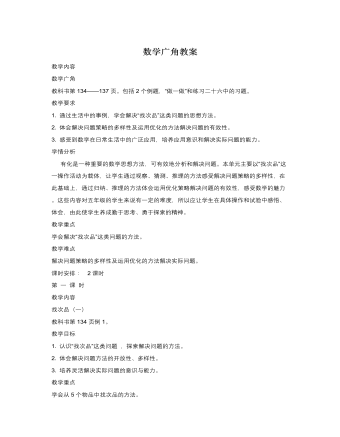
人教版新课标小学数学五年级下册数学广角教案
教学要求1. 通过生活中的事例,学会解决“找次品”这类问题的思想方法。2. 体会解决问题策略的多样性及运用优化的方法解决问题的有效性。3. 感受到数学在日常生活中的广泛应用,培养应用意识和解决实际问题的能力。学情分析有化是一种重要的数学思想方法,可有效地分析和解决问题。本单元主要以“找次品”这一操作活动为载体,让学生通过观察、猜测、推理的方法感受解决问题策略的多样性,在此基础上,通过归纳、推理的方法体会运用优化策略解决问题的有效性,感受数学的魅力。这些内容对五年级的学生来说有一定的难度,所以应让学生在具体操作和试验中感悟、体会,由此使学生养成勤于思考、勇于探索的精神。教学重点学会解决“找次品”这类问题的方法。
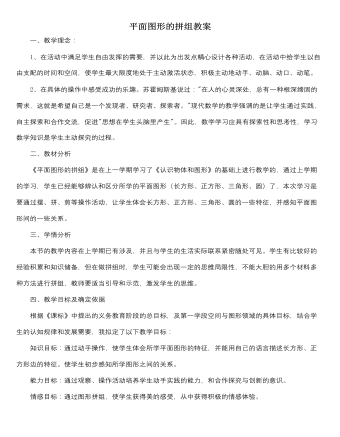
人教版新课标小学数学一年级下册平面图形的拼组教案
朋友们都听说了我们的神奇魔力,米老鼠也来请我们帮忙了,你们愿意帮他把墙修补好吗?(幻灯11,同时请一名同学到台前来亲自动手粘一下)在我们的帮助下,米老鼠家缺了10块砖的墙就被修补好了(幻灯12)七、拼图大比赛。1、师:现在请同学们运用自己手中的所有材料,发挥你的想象,可以自己拼,也可以和组员合作拼出自己喜欢的图形,比一比,看那些同学拼得又好又快,又有创意。 2、展示学生作品。学生自己评价或者互相评价。八、欣赏品评,知识延伸 师:同学们刚才拼的图形非常漂亮,老师很喜欢。生活中有许多地方都需要优美的图形的装饰,同学们也可以是一位小小设计师,设计出美丽的图案,装点生活,美化环境。(欣赏生活中的优秀装饰作品) 师:通过刚才的欣赏,你有什么想法?
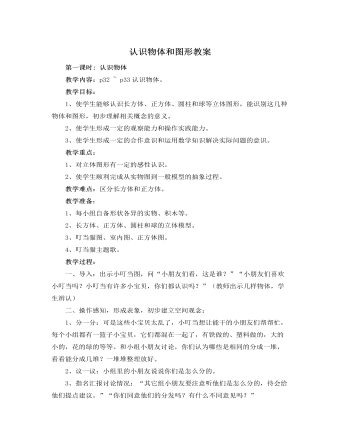
人教版新课标小学数学一年级上册认识物体和图形教案
1.让学生拿出长方体摸一摸,问:你有什么感觉?摸的的面是什么形状?师:谁来摸一摸,老师手上长方体的长方形在哪?(学生找出长方形)2.让学生在自己的学具(长方体、正方体、圆柱体)上找图形,并和小组里的同学说一说。3、指名说,教师把学生找到的图形从立体图形上分离出来,贴于黑板上,师:这些图形是物体上的一个面,这就是我们今天要认识的图形。(板书课题——认识平面图形)4.让学生说说:从什么物体上找到了什么图形?5.师:你能想办法把这些形状画到一张纸上吗?请学生演示各自不同的方法,然后教师在黑板上沿长方体的一个面画出长方形。师:你会画吗?请小朋友们用自己喜欢的办法画出并剪出长方形、正方形、圆和三角形各2个。
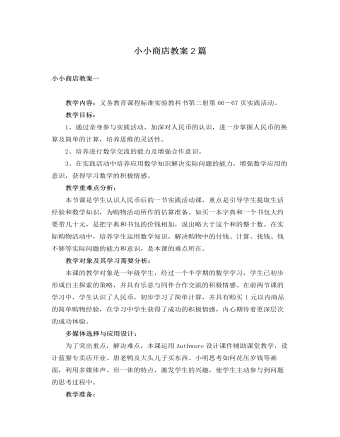
人教版新课标小学数学一年级下册小小商店教案2篇
3、同学们,你们看今天老师带来了什么?(出示一个学生喜欢的玩具)这是昨天老师去商店时买的,猜猜看,这个需要多少钱?(学生猜,教师可提示,最后得出正确标价)今天我们也来开个小小商店玩一玩买卖商品的游戏,想玩吗?4、选营业员及经理。我觉得当营业员最重要的是精通业务,计算能力强。谁想来当?(等学生举手后,教师选出4人。)考虑到我们呆会儿买的人会比较多,每个柜台一个营业员忙不过来,我还准备再选4名商店经理,做好以下几项工作:1)做好接待服务工作,顾客有困难能主动帮助。2)做好买卖过程中的组织工作,让大家有秩序地买商品。3)当营业员计算碰到困难时,两人能商量着解决。觉得自己能做到以上三点的同学可举手参加竞选。(学生举手后,选出4名经理)
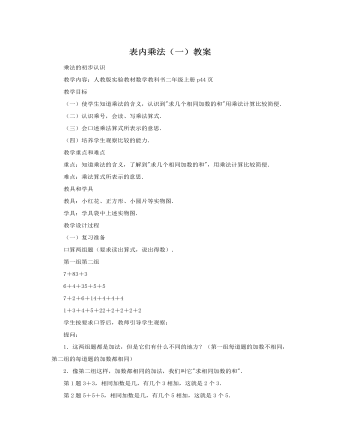
人教版新课标小学数学二年级上册表内乘法(一)教案
(6)交流。6的乘法口诀一共有几句?口诀中的第一个数与算式中的第二个因数相同,表示什么?口诀中的第二个数与算式的第一个因数相同,表示什么?相邻两句口诀的积相差几?哪几句难记一些?你用什么方法记呢?怎样记住"三六十八"、"四六二十四"两句口诀?教师在学生发言的基础上鼓励学生大胆说、想出不同记口诀的方法。(7)应用"做一做"第1题(学生半独立完成):①用6根小棒摆1个六边形;②摆2个六边形要用多少根小棒?你是怎样想的?(想口诀"二六十二"。)③运用所学的口诀口答摆4个、6个、3个、5个六边形所需要向小棒数。"做一做"第2题(独立完成):①将第2题改为填空题,在圆圈内填写正确的积;②口答得数,并说一说所用口诀。
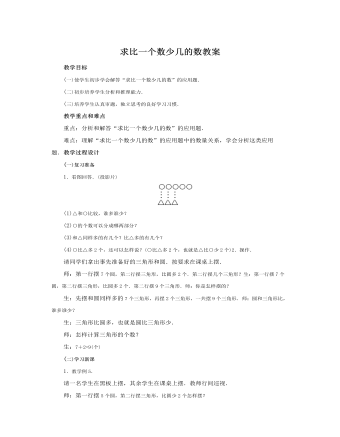
人教版新课标小学数学二年级上册求比一个数少几的数教案
课堂教学设计说明求比一个数少几的数的应用题是低年级教学的一个难点.为了分散难点,在复习准备阶段做了孕伏.如:圆比三角形多2个,也可以说三角形比圆少2个.为了突破难点,让学生动手摆、动口说、动笔写,全方位地调动学生的各种感官参与教学全过程,使学生在参与学习的活动中领悟出“求比一个数少几的数”的应用题仍然是把较大数看作两部分组成的,从大数中去掉大数比小数多的部分,就是小数与大数同样多的部分,也就是小数的数值.也可以通过“假设同样多”去透彻地理解比一个数少几的实际意义.确实使学生理解和掌握了这类应用题用减法计算的道理和解答方法.为了让学生进一步加深理解和掌握“求比一个数少几的数”的应用题的数量关系和解答方法,在巩固练习的最后设计了一组对比题目.
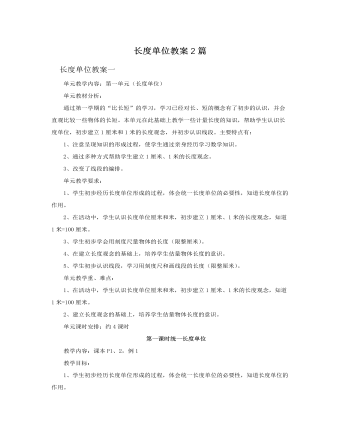
人教版新课标小学数学二年级上册长度单位教案2篇
l尺子上每相邻的两条长刻度线之间的一大格的长度都是1厘米。师:我们大家现在一起用手比划一下,1厘米多长。互相看一下,计住了吗?闭上眼睛想一想,1厘米有多长。3、认识几厘米师:我们现在知道1厘米有多长了,那3厘米又有多长呢?师:同学们还能在尺子上找到其他3厘米的长度吗?4、用厘米量师:刚才上课时,老师展示的2根线绳,到底哪一根长一点呢?现在,同学们先估计一下这两根线绳各自多长,然后在测量比较一下,好吗?师:结果是哪根线绳长一点呢?能说说你是怎么量的吗?三、知识拓展1、师:老师这里有一把尺子,可是它断了一节,没有刻度“0”,只剩下刻度3到刻度10,那么这把尺子能不能用来量物体的长度啊?同学们能不能帮老师想一想办法,好吗?2、其他测量长度的工具(课件展示)
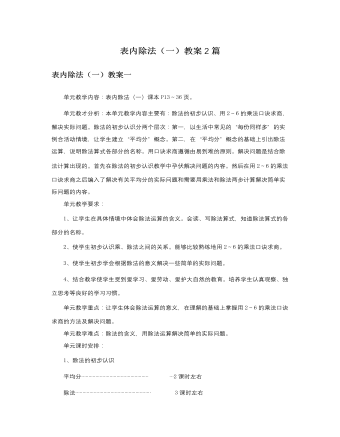
人教版新课标小学数学二年级下册表内除法(一)教案2篇
教后反思本节课给学生创设了良好的活动空间,把学生实际生活中听说过的见到的平均分现象展示给学生看,把生活和数学联系起来,在学生感受“同样多”的基础上概括出什么叫平均分。揭示平均分这一数学知识在生活中的应用,之后突出了学生三次实际操作。第一次,小组同学互相分水果,重视学生分的结果。体会感受“平均分”的含义。第二次,重视分法:15个橘子平均分成5份。体现了学生对物品的不同分法,建立了平均分的概念。第三次,分矿泉水,通过份数变化,观察分的就结果,深刻体会“平均分”,为认识除法积累丰富的知识。为学生营造探索的空间。第二课时:平均分的认识(二)教学内容巩固“平均分”。课本第15页的例题3。教学目标1.巩固“平均分”的概念,知道平均分就是每一份分得结果同样多。
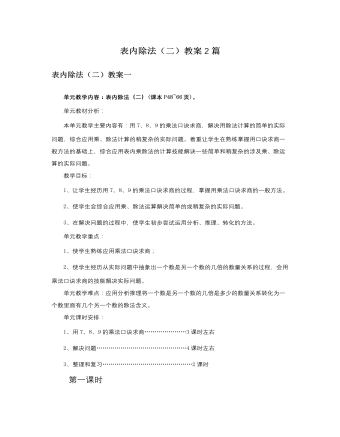
人教版新课标小学数学二年级下册表内除法(二)教案2篇
三维目标1.知识与技能(1)让学生经历用7、8、9的乘法口诀求商的过程,掌握用乘法口诀求商的一般方法。(2)使学生会综合应用乘、除法运算解决简单的或稍复杂的实际问题。2.过程与方法在解决问题的过程中,让学生初步尝试运用分析、推理和转化的学习方法。3.情感、态度与价值观让学生在学习中体验到成功的喜悦,增强学生学好数学的信心。重、难点与关键1.重点:使学生熟练应用乘法口诀求商,经历从实际问题中抽象出一个数是另一个数的几倍的数量关系的过程,会用乘法口诀求商的技能解决实际问题。2.难点:应用分析推理将一个数是另一个数的几倍是多少的数量关系转化为一个数里面有几个另一个数的除法含义。3.关键:以解决问题为载体,培养学生的数感。
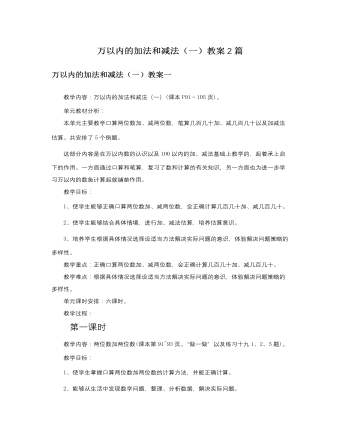
人教版新课标小学数学二年级下册万以内的加法和减法(一)教案2篇
3.小结。引导学生归纳两位数加减法的口算步骤:要把加上或减去的两位数看成一个整十数和一个一位数,先算两位数加、减整十数,再算两位数加减一位数。三、巩固练习课本第93页的做一做。分别指名口算,并说说怎么想的。四、全课总结1.根据学生回答,教师归纳小结并出示课题:口算两位数加、减两位数。2.口算两位数加、减两位数应注意什么?五、布置作业教后反思《标准》提倡算法多样化,目的是提倡学生个性化的学习。本单元仍然注意体现这一理念,如本课时教学口算两位数加、减两位数时,既呈现了口算方法,还出现了在脑中想竖式的方法;在教学笔算时,还出现口算的方法。其目的就是鼓励学生展开思路,在交流、比较的基础上不断地完善自己的想法,学习计算方法。